The OCZ Vector 180 (240GB, 480GB & 960GB) SSD Review
by Kristian Vättö on March 24, 2015 2:00 PM EST- Posted in
- Storage
- SSDs
- OCZ
- Barefoot 3
- Vector 180
AnandTech Storage Bench - The Destroyer
The Destroyer has been an essential part of our SSD test suite for nearly two years now. It was crafted to provide a benchmark for very IO intensive workloads, which is where you most often notice the difference between drives. It's not necessarily the most relevant test to an average user, but for anyone with a heavier IO workload The Destroyer should do a good job at characterizing performance.
| AnandTech Storage Bench - The Destroyer | ||||||||||||
| Workload | Description | Applications Used | ||||||||||
| Photo Sync/Editing | Import images, edit, export | Adobe Photoshop CS6, Adobe Lightroom 4, Dropbox | ||||||||||
| Gaming | Download/install games, play games | Steam, Deus Ex, Skyrim, Starcraft 2, BioShock Infinite | ||||||||||
| Virtualization | Run/manage VM, use general apps inside VM | VirtualBox | ||||||||||
| General Productivity | Browse the web, manage local email, copy files, encrypt/decrypt files, backup system, download content, virus/malware scan | Chrome, IE10, Outlook, Windows 8, AxCrypt, uTorrent, AdAware | ||||||||||
| Video Playback | Copy and watch movies | Windows 8 | ||||||||||
| Application Development | Compile projects, check out code, download code samples | Visual Studio 2012 | ||||||||||
The table above describes the workloads of The Destroyer in a bit more detail. Most of the workloads are run independently in the trace, but obviously there are various operations (such as backups) in the background.
| AnandTech Storage Bench - The Destroyer - Specs | ||||||||||||
| Reads | 38.83 million | |||||||||||
| Writes | 10.98 million | |||||||||||
| Total IO Operations | 49.8 million | |||||||||||
| Total GB Read | 1583.02 GB | |||||||||||
| Total GB Written | 875.62 GB | |||||||||||
| Average Queue Depth | ~5.5 | |||||||||||
| Focus | Worst case multitasking, IO consistency | |||||||||||
The name Destroyer comes from the sheer fact that the trace contains nearly 50 million IO operations. That's enough IO operations to effectively put the drive into steady-state and give an idea of the performance in worst case multitasking scenarios. About 67% of the IOs are sequential in nature with the rest ranging from pseudo-random to fully random.
| AnandTech Storage Bench - The Destroyer - IO Breakdown | |||||||||||
| IO Size | <4KB | 4KB | 8KB | 16KB | 32KB | 64KB | 128KB | ||||
| % of Total | 6.0% | 26.2% | 3.1% | 2.4% | 1.7% | 38.4% | 18.0% | ||||
I've included a breakdown of the IOs in the table above, which accounts for 95.8% of total IOs in the trace. The leftover IO sizes are relatively rare in between sizes that don't have a significant (>1%) share on their own. Over a half of the transfers are large IOs with one fourth being 4KB in size.
| AnandTech Storage Bench - The Destroyer - QD Breakdown | ||||||||||||
| Queue Depth | 1 | 2 | 3 | 4-5 | 6-10 | 11-20 | 21-32 | >32 | ||||
| % of Total | 50.0% | 21.9% | 4.1% | 5.7% | 8.8% | 6.0% | 2.1% | 1.4 | ||||
Despite the average queue depth of 5.5, a half of the IOs happen at queue depth of one and scenarios where the queue depths is higher than 10 are rather infrequent.
The two key metrics I'm reporting haven't changed and I'll continue to report both data rate and latency because the two have slightly different focuses. Data rate measures the speed of the data transfer, so it emphasizes large IOs that simply account for a much larger share when looking at the total amount of data. Latency, on the other hand, ignores the IO size, so all IOs are given the same weight in the calculation. Both metrics are useful, although in terms of system responsiveness I think the latency is more critical. As a result, I'm also reporting two new stats that provide us a very good insight to high latency IOs by reporting the share of >10ms and >100ms IOs as a percentage of the total.
I'm also reporting the total power consumed during the trace, which gives us good insight into the drive's power consumption under different workloads. It's better than average power consumption in the sense that it also takes performance into account because a faster completion time will result in less watt-hours consumed. Since the idle times of the trace have been truncated for faster playback, the number doesn't fully address the impact of idle power consumption, but nevertheless the metric is valuable when it comes active power consumption.
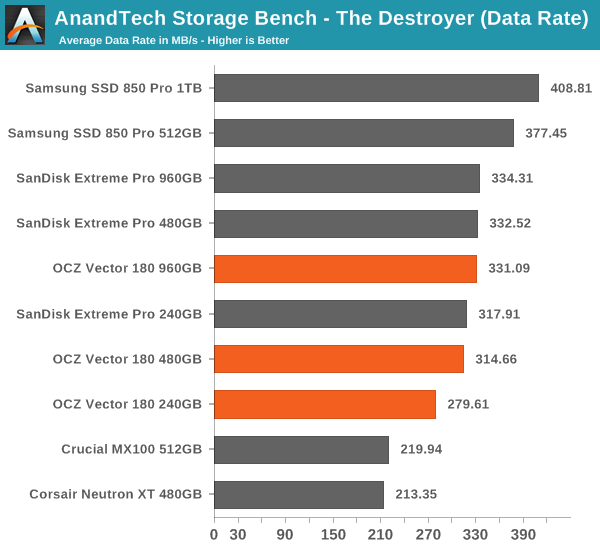
For a high-end drive, the Vector 180 has average data rate in our heaviest 'The Destroyer' trace. At 480GB and 960GB it's able to keep up with the Extreme Pro, but the 240GB model doesn't bear that well when compared to the competition.
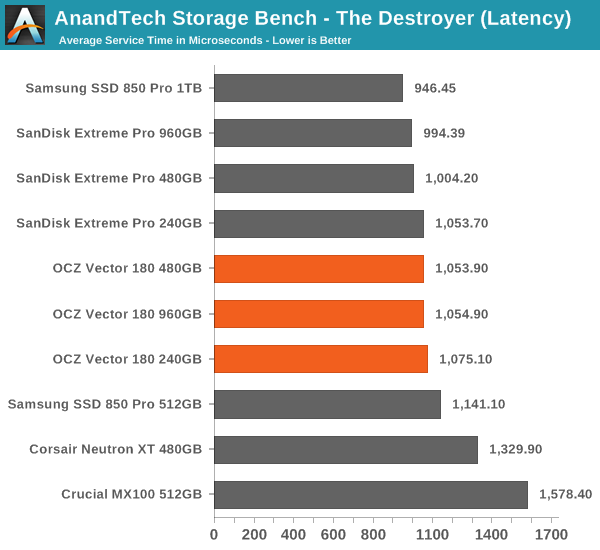
The same story continues when looking at average latency, although I have to say that the differences between drives are quite marginal. What's notable is how consistent the Vector 180 is regardless of the capacity.
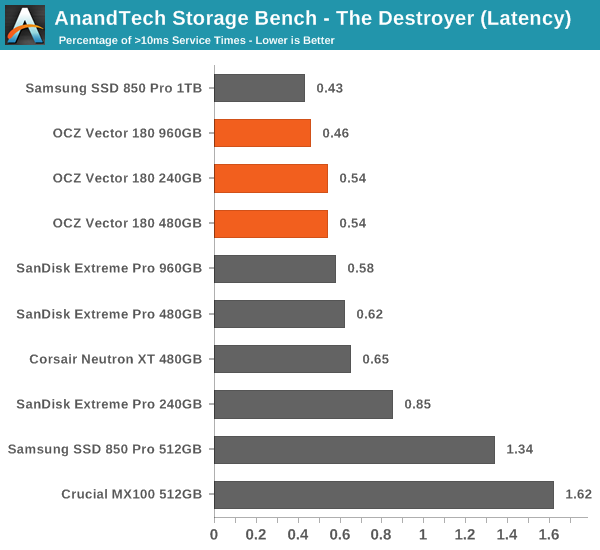
Positively, the Vector 180 has very few high latency IOs and actually leads the pack when looking at all capacities.
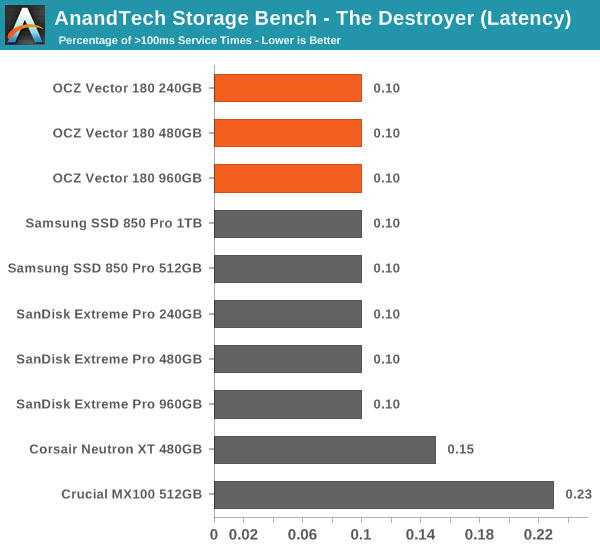
The Vector 180 also appears to be very power efficient under load and manages to beat every other SSD I've run through the test so far. Too bad there is no support for slumber power modes because the Barefoot 3 seems to excel otherwise when it comes to power.
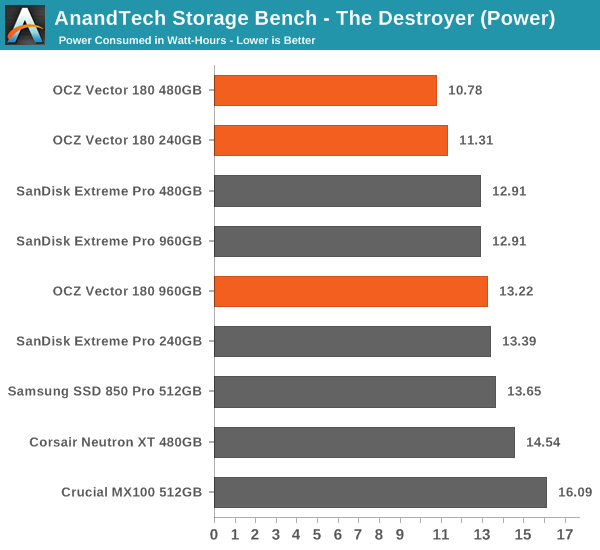










89 Comments
View All Comments
sfc - Wednesday, March 25, 2015 - link
Fool me once, shame on, shame on me. A fool me can't get fooled again.I *KNEW* OCZ was a garbage company after all the havoc they caused in the late 90s/early 00s with their crap memory products. It sounded alarm bells in my head that reminded me of their fake address that was literally an empty storefront.
But I read all the press, heard how it was just the same name but a different backing company. So I bought one of their SSDs like a fool, only to send it back multiple times and everytime have it die again. I still have an 80GB intel SSD I bought several years before the OCZ that's still kicking.
After all that, I find out the same crook selling crap memory was behind the "new" OCZ. Pulling his same parlor tricks giving review sites hand-picked models and sending bottom barrel reject flash to customers. You should just refuse to review any more of their hardware, they're crooks and their wares are trash.
Jahzah_1 - Wednesday, March 25, 2015 - link
Just picked up a Samsung 850 Evo for $204 at Microcenter (price matched to Newegg), last Saturday. Don't understand the justification by OCZ to price the 480GB version at $275.Jahzah_1 - Wednesday, March 25, 2015 - link
That is $204 for the 500GB Evo.mapesdhs - Wednesday, March 25, 2015 - link
As I understand the intent of this product, it's aimed at the likes of the Extreme Proand 850 Pro. The Arc 100 is the mainstream competitor to the EVO, which is $196
on newegg for the 480GB.
Ian.
Jahzah_1 - Thursday, March 26, 2015 - link
oh, I see. What I didn't take into account was the fairly inexpensive nature of 3D-Nand production. So Samsung has an edge it seems, to set their mid-range drives at that price.rocketman122 - Thursday, March 26, 2015 - link
Ive had nothing but bad experience with OCZ. I had mem go bad, rma and sold them. I had the core 64 SSD that the company knew were problematic and still didnt have integrity to not sell them. that core SSD cost me quite chunk of money and I suffered with that. I never forI hope they go out of business and stop selling their gear to the public. we need companies with reliable gear.
ocztosh - Monday, March 30, 2015 - link
Hello rocketman122, thank you for your comments and sorry to hear that you had issues with the Core Series. The old company no longer exists and the IP was purchased by Toshiba. As OCZ Storage Solutions - A Toshiba Group Company we have completely redone our products and processes and there has been a great focus on quality throughout the organization. Everything from the product design cycle through manufacturing has been updated. By implementing our own in-house controller and firmware technology and having access to premium Toshiba NAND we are now able to impact this better than ever. We believe we have a very competitive offering today when it comes to reliability and product quality and hope that we will have the opportunity to prove it to you in the future. Thank you again for your previous business.loimlo - Thursday, March 26, 2015 - link
Good SSD review as usual. Kudos to Kristian's efforts.Btw, I wonder the M-I-A BX100 review. Can we expect it ?
Kristian Vättö - Friday, March 27, 2015 - link
It's coming. This month has been full of NDAs, which have postponed the BX100 review, but once I'm done with next week's NDAs the BX100 will be getting my full attention :)loimlo - Saturday, March 28, 2015 - link
Thanks for clarification. Take your time to do it ~~